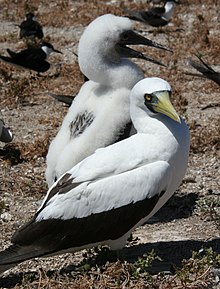Published June 6, 2016
7:26pm
By AMADO BAJARIAS JR.
 On May 11, 2016, in the grey
early morning light on a remote coralline isle in the middle of the Sulu Sea, a
group of researchers and marine park rangers saw an animal that no one has seen
in the area for more than 20 years.
On May 11, 2016, in the grey
early morning light on a remote coralline isle in the middle of the Sulu Sea, a
group of researchers and marine park rangers saw an animal that no one has seen
in the area for more than 20 years.
First sighting of Masked Booby in
Tubbataha after 20 years
It was a Masked Booby (Sula dactylatra), a large and strikingly plumaged seabird, that was last seen on Bird Islet in the North Atoll of the Tubbataha Reefs Natural Park (TRNP), Palawan, in 1995.
The Masked Booby, which is the
biggest and heaviest of the six surviving booby species in the bird family
Sulidae, was observed on the mornings of May 11 and 12 by a survey team led by
environment and natural resources management specialist Arne Jensen, who has
studied the seabirds in Tubbataha for more than 25 years and is chief
consultant of the Tubbataha Management Office on the management of seabirds.
The team was on Bird Islet, which
is about 170 kilometers southeast of Puerto Princesa, to conduct a census of
seabirds and their breeding areas in TRNP. The team has held several surveys
over the past years but this is the first time that it has recorded the Masked
Booby.
The Wild Bird Club of the
Philippines Checklist of Birds of the Philippines 2016 declares the Masked
Booby as “Extirpated,” with the last sighting of a resident bird from “North
Islet, Tubbataha Reefs, Palawan (1995).” The checklist notes one sub-adult
documented “off Babuyan Islands, Cagayan (2003).” With the Philippine
population believed to be gone, any new sighting is presumed to be of
individuals that have strayed from abroad.
The team observed the lone Masked
Booby standing and walking among Brown Booby (Sula leucogaster) and Greater Crested Tern (Thalasseus bergii), which, along with Brown Noddy (Anous stolidus), Black Noddy (Anous minutus), Sooty Tern (Onychoprion fuscatus), and Red-footed
Booby (Sula sula), roost and nest in
dense colonies on the uninhabited islet.
No comments:
Post a Comment